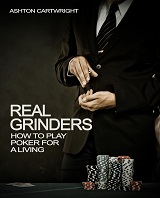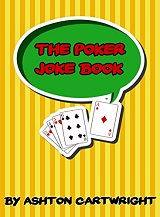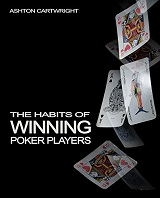Bankroll in Poker

Bankroll
A “bankroll” is an amount of money set aside specifically for the purpose of playing poker.
The management of your bankroll is a seemingly mundane, yet incredibly vital aspect of overall poker strategy and direction. The importance of correct bankroll management is underestimated by good and bad players alike, but the simple truth is that a player who practices sound bankroll management is much more likely to be successful. In fact, without proper bankroll management, it is almost impossible to become a professional player.
Someone playing within proper bankroll limits is much less likely to “go bust” due to an unlucky run of card. They will be able to make the correct plays, even if the plays are high variance, because they won’t be playing with “scared money”. Most importantly, they will be able to move up limits in a way that minimizes risk, but still allows for consistent growth.
There are many players that could make a significant income playing poker, if it wasn’t for the fact that they let themselves down by poor bankroll management. It doesn’t matter how good a player you are: sometimes your Aces are going to get cracked. If that happens a few times in succession, it’s your bankroll management that will determine if you can keep playing, or if you have to wait for your next paycheque to try again.
What a bankroll is not
A bankroll is not “all the money you have in the world”. It is not the money you should be using to pay rent. It is not your college fund. It is not the money you were putting aside to get the car fixed. It is not the deposit that you were saving for a house.
A bankroll is money that you have set aside SPECIFICALLY for playing poker. Think of it like investing money in a business: your business needs capital to run, but if your business performs well, and if you don’t spend your capital on risky things, then you can expect the amount that you have invested to grow. This growth can be reinvested into the business to grow still further, or you can take that profit and spend it however you like, as long as you leave enough for your business to keep running.
It might be $50 in an online poker account, or it might be $50,000 set aside for playing high stakes at a casino, but whatever the amount, the important thing is that it is money that can be used entirely for poker.
Who does not need a bankroll?
1. Losing players. Whatever money a losing player sets aside for a bankroll will eventually be gone, and then they will have to dip into their own pocket to keep playing poker. There is no bankroll strategy that can be of enduring benefit to a losing player unfortunately. Study combined practice at micro-stake levels should be their focus instead.
2. Casual players do not need a bankroll. If you only play poker every couple of months, then a bankroll is probably not required. As long as you only ever play with money that you don’t mind losing, it doesn’t really matter what that amount is, or whether or not it grows.
Who does need a bankroll?
1. Anyone who is playing poker for the purpose of making a profit. If your intention is just to have fun that’s A-ok, but if your intention is to make a profit over any reasonable period of time, then you need a bankroll.
2. Anyone who plays poker often, at stakes that are relevant to that player. If you’re playing poker every week, and buying in for amounts that are not negligible to you, then you are definitely at the stage where you need a bankroll.
3. Anyone who wants to derive some proportion of their income from playing poker. You don’t necessarily need to be a pro, but if you have come to rely on the extra money you usually make on Friday nights at a local home game, then you need a bankroll.
Bankroll Strategy
The bankroll strategy that I use is very straight forward. The exact numbers may vary, but most serious poker players will use a system reasonably similar. The strategy is this:
Cash games:
I always maintain a bankroll of at least 20 maximum buy-ins at any cash game level I’m playing.
Once my bankroll builds up to 30 buy-ins at the next level higher, I move up to that level.
So when I’m playing 50c/$1 blinds, I’m buying in for the maximum $100 per table and my bankroll is $3000. The next level up is the $1/$2 blind level, with $200 max buy-ins, so when my bankroll gets to $6000 ($200 X 30), I move up to that level.
If my bankroll drops below 20 buy-ins at my current level, then I step down to a lower level again until my bankroll builds back up to 30 buy-ins.
It is a very simple strategy that works well for me. If you are a bit more conservative, then perhaps you would move up limits when you have 50 buy-ins at the next level, and move down again if you fall below 30 buy-ins. Choose whatever amounts you feel comfortable with, but I wouldn’t recommend going any lower that 20 buy-ins. Its not uncommon to lose a few buy-ins within an hour or two if the cards run against you, so make sure you have a comfortable enough buffer to protect yourself.
Tournaments/Sit ‘n’ Goes
For tournaments and SNGs I am extremely conservative in my bankroll management. I will only enter tournaments and SNGs for which my bankroll is 100 times the size of the entry.
If my bankroll is $1,000 then I can enter tournaments and SNGs with an entry price of no more than $10. Once my bankroll increases to $1,500 I can enter tournaments and SNGs with a $15 entry price.
I can recall instances where I have played 16 straight SNGs without cashing a single time. In those situations, I was very glad that I was not committing more than 1% of my bankroll to each entry. SNGs have a high variance, tournaments even higher, and so I have given myself an adequate buffer by only committing 1% of bankroll per entry.
If you are willing to accept greater risk, then perhaps committing no more than 2% of your bankroll per entry would suit you better. That’s 50 buy-ins. I would personally feel a bit uncomfortable with only 50 buy-ins at any tournament level that I was playing frequently, but I’m definitely more conservative than many players.
One last note on tournament entries: If there is a one-off tournament that you have had your heart set on playing, then it’s OK to go a bit out of your bankroll to play in it. But just keep in mind that if you commit too much of you bankroll to a single tournament and you don’t cash, you might have to move down to a lower limit until you can build your bankroll back up again.
In all forms of poker, if you are a winning player, and you stick to your bankroll strategy, then you will be able to continue moving up the limits as your bankroll grows. You will be insulated from the swings that occur in any game where luck/probability plays a part, while still being able to benefit from your development as a poker player. . . and you wont ever need to wait for your next paycheque to play again.



 Follow
Follow